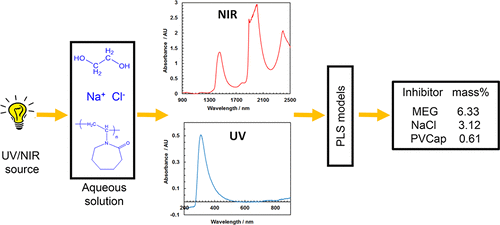当前位置:
X-MOL 学术
›
Ind. Eng. Chem. Res.
›
论文详情
Our official English website, www.x-mol.net, welcomes your
feedback! (Note: you will need to create a separate account there.)
Integrated Near Infrared and Ultraviolet Spectroscopy Techniques for Determination of Hydrate Inhibitors in the Presence of NaCl
Industrial & Engineering Chemistry Research ( IF 3.8 ) Pub Date : 2018-08-21 , DOI: 10.1021/acs.iecr.8b02372 Reza K. Haghi 1, 2 , Jinhai Yang 1 , Bahman Tohidi 1
Industrial & Engineering Chemistry Research ( IF 3.8 ) Pub Date : 2018-08-21 , DOI: 10.1021/acs.iecr.8b02372 Reza K. Haghi 1, 2 , Jinhai Yang 1 , Bahman Tohidi 1
Affiliation

|
Injection of chemical inhibitors is the most widely used method to prevent the formation of gas hydrates in gas transporting pipelines. It is usual that a high dosage of hydrate inhibitors has to be applied to minimize the risk of hydrate blockages, which can cause more operation costs and severe environmental damage. Monitoring the concentration of hydrate inhibitors in the pipeline could help the operator to determine the hydrate safety margin accurately therefore optimizing the inhibitor injection rate (i.e., ensuring adequate inhibition and avoiding over inhibition). In this study, the application of spectroscopic techniques was investigated to measure the concentration of both thermodynamic and low dosage hydrate inhibitors in water/brine by coupling UV and NIR spectra.Various partial least-squares (PLS) regression models were developed and evaluated at three different spectral regions (1400–1600, 1600–1850, and 1400–1850 nm) to determine the concentration of hydrate inhibitors and NaCl in three different inhibition systems: (a) monoethylene glycol (MEG)-NaCl, (b) methanol (MeOH)-NaCl, and (c) poly(N-vinylcaprolactam) (PVCap)-MEG-NaCl. The developed PLS models were further evaluated for a typical MEG-NaCl inhibition system by determining the concentration of MEG and NaCl during natural gas hydrate formation and dissociation. The results confirmed that the integrated NIR-UV spectroscopy technique can be used as a simple, quick, and reliable means for monitoring simultaneously the hydrate inhibitors and NaCl in pipelines.
中文翻译:

集成的近红外和紫外光谱技术在NaCl存在下测定水合物抑制剂
注入化学抑制剂是防止气体输送管道中气体水合物形成的最广泛使用的方法。通常必须使用高剂量的水合物抑制剂,以最大程度地降低水合物堵塞的风险,因为水合物堵塞会导致更高的运营成本和严重的环境破坏。监测管道中水合物抑制剂的浓度可以帮助操作员准确确定水合物安全裕度,从而优化抑制剂的注入速率(即确保充分抑制并避免过度抑制)。在这项研究中,研究了光谱技术的应用,以通过耦合UV和NIR光谱来测量水/盐水中热力学抑制剂和低剂量水合物抑制剂的浓度。开发了各种偏最小二乘(PLS)回归模型,并在三个不同的光谱区域(1400–1600、1600–1850和1400–1850 nm)进行了评估,以确定三种不同抑制系统中水合物抑制剂和NaCl的浓度:( a)单乙二醇(MEG)-NaCl,(b)甲醇(MeOH)-NaCl和(c)聚(N-乙烯基己内酰胺)(PVCap)-MEG-NaCl。通过确定天然气水合物形成和分解过程中MEG和NaCl的浓度,进一步评估了开发的PLS模型的典型MEG-NaCl抑制系统。结果证实,集成的NIR-UV光谱技术可以用作同时监测管道中水合物抑制剂和NaCl的简单,快速和可靠的手段。和1400–1850 nm)确定三种不同抑制系统中水合物抑制剂和NaCl的浓度:(a)单乙二醇(MEG)-NaCl,(b)甲醇(MeOH)-NaCl和(c)聚(N-乙烯基己内酰胺)(PVCap)-MEG-NaCl。通过确定天然气水合物形成和分解过程中MEG和NaCl的浓度,进一步评估了开发的PLS模型的典型MEG-NaCl抑制系统。结果证实,集成的NIR-UV光谱技术可以用作同时监测管道中水合物抑制剂和NaCl的简单,快速和可靠的手段。和1400–1850 nm)确定三种不同抑制系统中水合物抑制剂和NaCl的浓度:(a)单乙二醇(MEG)-NaCl,(b)甲醇(MeOH)-NaCl和(c)聚(N-乙烯基己内酰胺)(PVCap)-MEG-NaCl。通过确定天然气水合物形成和分解过程中MEG和NaCl的浓度,进一步评估了开发的PLS模型的典型MEG-NaCl抑制系统。结果证实,集成的NIR-UV光谱技术可以用作同时监测管道中水合物抑制剂和NaCl的简单,快速和可靠的手段。通过确定天然气水合物形成和分解过程中MEG和NaCl的浓度,进一步评估了开发的PLS模型的典型MEG-NaCl抑制系统。结果证实,集成的NIR-UV光谱技术可以用作同时监测管道中水合物抑制剂和NaCl的简单,快速和可靠的手段。通过确定天然气水合物形成和分解过程中MEG和NaCl的浓度,进一步评估了开发的PLS模型的典型MEG-NaCl抑制系统。结果证实,集成的NIR-UV光谱技术可以用作同时监测管道中水合物抑制剂和NaCl的简单,快速和可靠的手段。
更新日期:2018-08-21
中文翻译:

集成的近红外和紫外光谱技术在NaCl存在下测定水合物抑制剂
注入化学抑制剂是防止气体输送管道中气体水合物形成的最广泛使用的方法。通常必须使用高剂量的水合物抑制剂,以最大程度地降低水合物堵塞的风险,因为水合物堵塞会导致更高的运营成本和严重的环境破坏。监测管道中水合物抑制剂的浓度可以帮助操作员准确确定水合物安全裕度,从而优化抑制剂的注入速率(即确保充分抑制并避免过度抑制)。在这项研究中,研究了光谱技术的应用,以通过耦合UV和NIR光谱来测量水/盐水中热力学抑制剂和低剂量水合物抑制剂的浓度。开发了各种偏最小二乘(PLS)回归模型,并在三个不同的光谱区域(1400–1600、1600–1850和1400–1850 nm)进行了评估,以确定三种不同抑制系统中水合物抑制剂和NaCl的浓度:( a)单乙二醇(MEG)-NaCl,(b)甲醇(MeOH)-NaCl和(c)聚(N-乙烯基己内酰胺)(PVCap)-MEG-NaCl。通过确定天然气水合物形成和分解过程中MEG和NaCl的浓度,进一步评估了开发的PLS模型的典型MEG-NaCl抑制系统。结果证实,集成的NIR-UV光谱技术可以用作同时监测管道中水合物抑制剂和NaCl的简单,快速和可靠的手段。和1400–1850 nm)确定三种不同抑制系统中水合物抑制剂和NaCl的浓度:(a)单乙二醇(MEG)-NaCl,(b)甲醇(MeOH)-NaCl和(c)聚(N-乙烯基己内酰胺)(PVCap)-MEG-NaCl。通过确定天然气水合物形成和分解过程中MEG和NaCl的浓度,进一步评估了开发的PLS模型的典型MEG-NaCl抑制系统。结果证实,集成的NIR-UV光谱技术可以用作同时监测管道中水合物抑制剂和NaCl的简单,快速和可靠的手段。和1400–1850 nm)确定三种不同抑制系统中水合物抑制剂和NaCl的浓度:(a)单乙二醇(MEG)-NaCl,(b)甲醇(MeOH)-NaCl和(c)聚(N-乙烯基己内酰胺)(PVCap)-MEG-NaCl。通过确定天然气水合物形成和分解过程中MEG和NaCl的浓度,进一步评估了开发的PLS模型的典型MEG-NaCl抑制系统。结果证实,集成的NIR-UV光谱技术可以用作同时监测管道中水合物抑制剂和NaCl的简单,快速和可靠的手段。通过确定天然气水合物形成和分解过程中MEG和NaCl的浓度,进一步评估了开发的PLS模型的典型MEG-NaCl抑制系统。结果证实,集成的NIR-UV光谱技术可以用作同时监测管道中水合物抑制剂和NaCl的简单,快速和可靠的手段。通过确定天然气水合物形成和分解过程中MEG和NaCl的浓度,进一步评估了开发的PLS模型的典型MEG-NaCl抑制系统。结果证实,集成的NIR-UV光谱技术可以用作同时监测管道中水合物抑制剂和NaCl的简单,快速和可靠的手段。











































 京公网安备 11010802027423号
京公网安备 11010802027423号